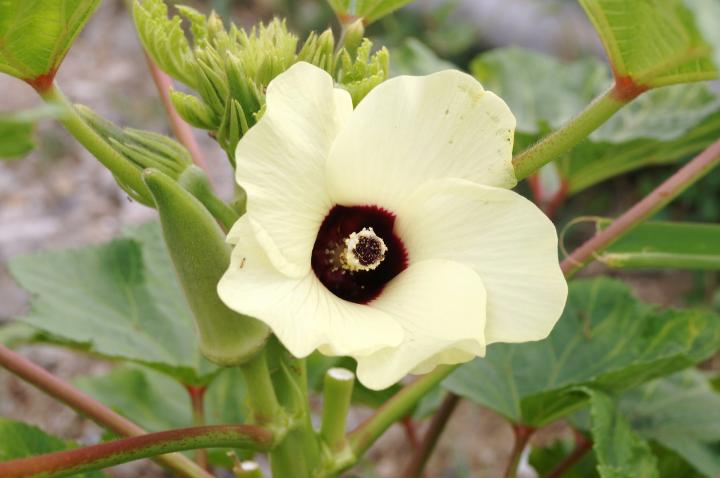Okra is traditionally a southern U.S. plant that thrives in warm weather. Here’s how to grow okra plants in your own garden!
Okra is easy to grow and use and looks lovely throughout the growing season due to its beautiful flowers. It’s also rich in vitamin A and low in calories, which makes it a great addition to your diet.
If you look at the flower of okra, you’ll see a resemblance to a hibiscus flower. Yes, okra is a member of the hibiscus family.
Planting
When to Plant Okra
- You can start okra seeds indoors in peat pots under full light 3 to 4 weeks before the last spring frost date.
- In warmer areas, you can also sow okra seeds directly in your garden 3 to 4 weeks before the last spring frost date as long as you cover the plants with a cold frame or grow tunnel until the weather warms up fully. Make sure that the covering is 2 to 3 feet tall so that the plants have room to grow.
- If you do not start your okra plants early, wait until there is stable, warm weather. You can plant okra in the garden when the soil has warmed to about 65° or 70°F—the warmer, the better.

Choosing and Preparing a Planting Site
- As a warm-weather crop, okra appreciates full sun.
- Okra is adaptable and will grow in most soils, though it performs best in well-drained soil that’s rich in organic matter.
- Soil should ideally be on the acidic side, with a pH between 5.8 and 7.0, but it tolerates a wide range of soil.
How to Plant Okra
- If you are planting okra transplants, be sure to space them 1 to 2 feet apart to give them ample room to grow.
- Plant okra seeds about 1/2 to 1 inch deep and 12 to 18 inches apart in a row. You can soak the seeds overnight in tepid water to help speed up germination.
- Okra plants are tall, so space out the rows 3 to 4 feet apart.
Growing
How to Grow Okra
- Eliminate weeds when the plants are young, then mulch heavily to prevent more weeds from growing. Apply a layer of mulch 2 to 3 inches high.
- You should side-dress the plants with 10-10-10, aged manure, or rich compost (1/2 pound per 25 feet of row). You could also apply a balanced liquid fertilizer monthly. Learn more about soil amendments and preparing soil for planting.
- When the seedlings are about 3 inches tall, thin the plants so that they are 12 to 18 inches apart, if they aren’t already.
- Keep the plants well watered throughout the summer months; 1 inch of water per week is ideal, but use more if you are in a hot, arid region.
- After the first harvest, remove the lower leaves to help speed up production.
Pests/Diseases
- Aphids
- Corn earworms
- Stinkbugs
- Fusarium wilt
Recommended Varieties
- ‘Annie Oakley II’, which takes 52 days to mature and has spineless pods. It grows to about 4.5 feet tall.
- ‘Park’s Candelabra Branching’, which is a base-branching okra plant. This type of branching makes picking easy.
- ‘Cajun Delight’, which has spineless, dark-green pods and grows to about 4 feet tall.
- ‘Cajun Jewel’, dwarf at 2 1/2 to 4 feet tall; tasty 8-inch pods up to 1 inch in diameter.
- ‘Louisiana Green Velvet’ is good for big areas; it is vigorous and its plants grow to be 6 feet tall. It is also smooth and spineless.
- ‘Blondy’, spineless; dwarf at 3 feet tall; pale green 3-inch pods; ideal for northern growers.
- ‘Candle Fire’, a unique, 4-foot tall red okra with round pods that are not ribbed.
Harvesting
How to Harvest Okra
- The first harvest will be ready about 2 months after planting.
- Harvest the okra when it’s about 2 to 3 inches long. Harvest it every other day.
- Cut the stem just above the cap with a knife; if the stem is too hard to cut, the pod is probably too old and should be tossed.
- Wear gloves and long sleeves when cutting the okra because most varieties are covered with tiny spines that will irritate your skin, unless you have a spineless variety. Do not worry: this irritation will not happen when you eat them.

How to Store Okra
- To store okra, put the uncut and uncooked pods into freezer bags and keep them in the freezer. You can then prepare the okra any way you like throughout the winter months.
- You can also can okra to have it throughout the winter.
Wit and Wisdom
- Okra is sometimes called “lady’s fingers” thanks to the vegetable’s long, slender shape.
Recipes
Slow Cooker Jambalaya Soup
Smokey Chipotle Gumbo Stew
Cooking Notes
Okra can be consumed in a number of ways—raw, pickled, stir-fried—you name it!
Okra




